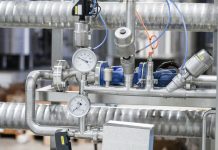
Development of a novel mechanism for low- and high pressure measurement with variable-thickness diaphragm.
In sensors currently available, pressure measurement is based on the movements of the elastic elements under different pressures. However, since their elasticity is limited, it is not possible to perform measurements over a wide range of parameter values. In this context, the objective of a recent study, carried out by a group of Iranian researchers (Yaghooti & Pak, 2023), was to propose an innovative system based on a mechanism for measuring low and high pressures concurrently.
In particular, this mechanism has a variable thickness diaphragm, and a protective part of the diaphragm filled with silicone oil. The designed mechanism was manufactured and used to test its behaviour under different pressures (0.1 to 150 bar). The validation was very positive as all measurements have an error of less than 0.15%.
In conclusion, the authors argue that the proposed mechanism can be easily implemented on existing pressure sensors and pressure gauges to improve their accuracy, at very limited costs. In general, the proposed mechanism can reduce the number of instruments to be installed on a plant due to its measurement flexibility. Future studies are desirable to carry out tests to further simplify the system by eliminating silicone oil.
Design and development of an innovative level sensor based on giant magnetoresistance.
Accurate level sensing plays an important role in various industrial sectors, including food industry. In this context, a recent study, carried out by a group of Indian researchers (Behera et al., 2023), introduced an innovative sensor for this measurement, based on giant magnetoresistance (GMR) technology. In particular, the proposed system is equipped with a stainless steel diaphragm connected to a permanent magnet that deflects on the application of a hydrostatic pressure, resulting in a change in the magnetic field gradient at the GMR sensor.
The GMR sensor chip develops a voltage output that is further amplified and corrected by a signal conditioning chip. Once designed and manufactured, the sensor was calibrated in the operating temperature range of 10 to 60 °C, in laboratory conditions, for different water height ranges of 0 to 2, 0 to 3 and 0 to 5 meters. The sensor performance was tested by installing it in an external tank. The results point out that the sensors showed linear output, total error of 1% full scale, excellent reproducibility.
In conclusion, although further studies are still needed to test the instrument even in the presence of process fluids, the proposed system is particularly interesting not only for its proven sensing accuracy, but also for the cost, which is decidedly limited and, therefore, highly competitive with that of systems currently available on the market.
References: Yaghooti & A. Pak, High Pressure Research, 43, 2023, 293-305; Behera et al., Measurement, 206, 2023, 112310.



